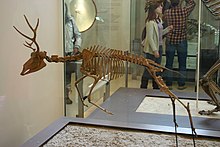Ramoceros
| Ramoceros Temporal range: Clarendonian
~ | |
|---|---|

| |
| Ramoceros osborni skeleton | |
| Scientific classification | |
| Domain: | Eukaryota |
| Kingdom: | Animalia |
| Phylum: | Chordata |
| Class: | Mammalia |
| Order: | Artiodactyla |
| Family: | Antilocapridae |
| Subfamily: | †Merycodontinae |
| Genus: | †Ramoceros Frick, 1937 |
| Species | |
| |
Ramoceros is an extinct genus of the artiodactyl family Antilocapridae endemic to Middle Miocene (Clarendonian) North America.[1]
Taxonomy[edit]
Ramoceros is one of several genera that originated from the subfamily Merycodontinae, of which the pronghorn is the only surviving remnant.[2] In fact, pronghorn is the only surviving remnant of the entire family Antilocapridae.[3]
Merriamoceros was originally placed in Ramoceros (as Ramoceros coronatus).[4]
Description[edit]

Ramoceros was a prehistoric relative of modern pronghorn (Antilocapra americana), which is a species of artiodactyl mammal indigenous to interior western and central North America.[1] The modern pronghorn weighs about 35 to 70 kilograms (77 to 154 lb), whereas the smaller Ramoceros generally weighed 10 to 20 kilograms (22 to 44 lb).[5]
The horns of Ramoceros are notable in that one horn, either the left or right, is always about three to four times larger than the other.[6]
Paleobiology[edit]
The long forked horns of Ramoceros may have been used by rival males in competition. Like other antilocaprids, Ramoceros regrew their horns every year, forming new horns growing on bony centers.[1]
Bibliography[edit]
- Vertebrate Palaeontology by Michael J. Benton
- The Evolution of Artiodactyls by Donald R. Prothero and Scott E. Foss
References[edit]
- ^ a b c Blount, Kitty and Crowley, Maggie. Encyclopedia of Dinosaurs & Prehistoric Life, p. 271 (Penguin, 2008).
- ^ Heffelfinger, Jim. Deer of the Southwest: A Complete Guide to the Natural History, Biology, and Management of Southwestern Mule Deer and White-tailed Deer, p. 26 (Texas A&M University Press, 2006).
- ^ Smithsonian Institution. North American Mammals: Pronghorn Antilocapra americana
- ^ Gregory, J. T. (1942). "Pliocene Vertebrates From Big Spring Canyon South Dakota". University of California Publications, Bulletin of the Department of Geological Sciences. 26 (4): 307–446.
- ^ Kues, Barry. The Paleontology of New Mexico, p. 364 (University of New Mexico Press, 2008).
- ^ Nebraska History: Volume 75. Nebraska State Historical Society. 1994. p. 49.
